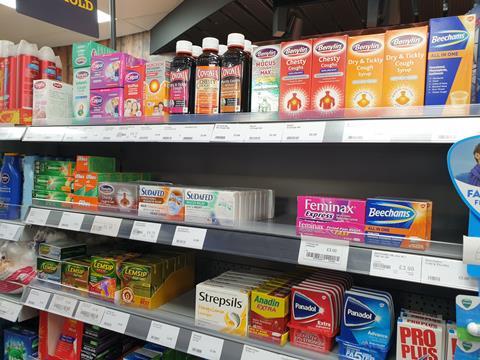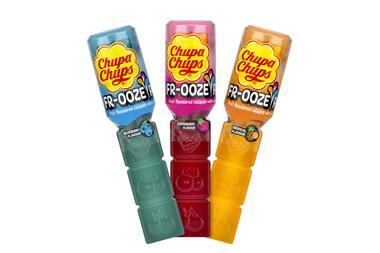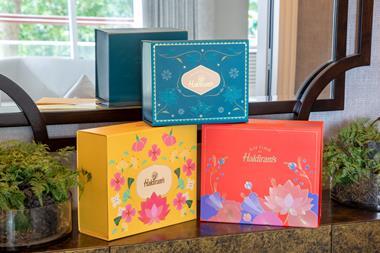Keep your category healthy this season with these vital insights
1. It’s going to be a bumper winter – for cold and flu bugs
2. OTC medicines are worth £116m in the independent convenience channel
3. Over four in ten shoppers can’t see their GP
4. Medicated confectionery has grown 35% in the last year
5. Medicines perform better on the shop floor
6. HFSS could cause a headache

1. It’s going to be a bumper winter – for cold and flu bugs
Feels like every shopper you serve has got the sniffles right now? You might well be right.
Because it’s not just shoppers that are enjoying the chance to circulate socially after a lonely lockdown. Cold and flu bugs are also loving more personal interaction, plus the chance to infect more people.
“We’ve seen the percentage of adults experiencing a cold in the last 12 months has increased by 12% to 37% [Mintel Insights] as a result of greater socialisation and interaction,” says Claire Campbell, Olbas brand manager.
“As this continues into the colder months, the government has warned that flu cases could rise to higher levels than before the pandemic in winter 2022.”
This is rubbish news for just about everyone except cold and flu brands. Yet it could also spark more demand for OTC products from shoppers.
Kuberan Tharmaraja, from Nisa Local T&K Food Mart in Ashford, Kent, installed a new medicine counter in July 2022 as part of a store refit. “It’s very early days yet, but I think it will do really well as the winter comes in,” he says. “It’s a real convenience area for us. People have coughs and colds that they need help with – they want to come in and select what they want easily and then get on with their day.”

2. OTC medicines are worth £116m in the independent convenience channel
Nielsen
Put simply, more colds and flu means more demand for relevant remedies.
“After a turbulent few years through the pandemic, with lockdowns and social distancing, year-on-year comparisons need to be taken in context,” says Matt Stanton, head of insight at DCS Group. “However, the simple message is that there is high shopper demand for OTC medicines in convenience stores.”
He cites cough, cold and flu (+102.8% YoY) and children’s medicines (+90.7% YoY) as two big growth areas in independent convenience (all figures winter 2021/22 compared to 2020/21).
“Strepsils are in very high growth in independent convenience (+124.4% YoY),” he adds.
“Other categories in strong growth, due to the lifting of lockdown restrictions, are adult pain (+16.6%) with more illnesses related to people mixing in groups and digestive health (+17.5%) due to increased numbers going on holiday or holding social events at home, such as BBQs [all stats Nielsen].”
Sexual wellbeing has also benefited from the end of lockdown as people hook up IRL (+10.6%) due to the lifting of lockdown restrictions.

3. Over four in ten shoppers can’t see their GP
One hangover from the pandemic is that shoppers are finding it a lot harder to see medical professionals when they need to. Which means that consumers are increasingly having to choose self-care.
“The NHS continues to be under pressure from the pandemic and the backlog of patients, with 44% of people unable to access healthcare when they need it [Mintel],” says Elizabeth Hughes-Gapper, Jakemans brand manager. “As a result, the NHS recommends that patients experiencing winter ailments – such as a cough or sore throat – can be self-medicated and often treated without seeing the GP.”
OTC medicine trade organisation PAGB actively promotes the importance of self care for empowering people to look after their own health and reduce pressure on the NHS. “Coughs and colds are amongst the most commonly experienced health conditions and a health area noted in our survey that people feel the most confident treating by themselves,” says CEO Michelle Riddals. “Helping people to care for themselves when that’s the most appropriate course of action will help to improve the sustainability of the NHS, at a time when the demands placed upon it by the backlog from Covid-19 remain high.”
Worcestershire retailer Chaz Chahal has seen a rising number of customers adopt a self care approach. “I think that more people are coming in for pain relief rather than waiting around for doctor’s appointment,” says Chaz who owns Costcutter and Simply Fresh stores in Worcestershire. “They know we sell medicines and that they can come in to use if they can’t get to a doctor or pharmacy.”

4. Medicated confectionery has grown 35% in the last year
Nielsen
Post-lockdown, medicated confectionery has also seen growth. Which isn’t surprising, since it’s a relative low-cost remedy which fits simply in existing sweet fixtures.
“The past two years have been a rollercoaster for the medicated confectionery sector,” explains Jon R White, regional business manager for Fisherman’s Friend in the UK. “Relentless lockdowns undeniably dented growth in our category, as people simply weren’t socialising – leading to a dramatic fall in the incidences of cold and flu, and a subsequent fall in demand for products relieving cold and flu symptoms.
“But now the picture is very different, as pandemic concerns lessen and many consumers are clearly eager to return to a level of normality.”
White says that the brand has grown 26.1% over the first three months of the cold season. A £1.5m marketing push (including a return to TV ads) should boost these figures even further.
Jakemans is also receiving investment, having seen one of the biggest share gains within medicated confectionery in value versus two years ago (IRI), claims brand owner Lanes Health. It states that Jakemans SKUs dominated the top selling bag lines and drove 89% of real value growth in bag formats within the last 12 months (ibid).
Packs have received a brand refresh and bag sizes have been updated to reflect changing consumer trends, with all Jakemans variants available in 73g and the top three selling varieties available in 160g sizes, as well as stick packs. The brand will be supported by a media campaign over winter and next spring.
Over at Mondelez International, trade communications head Susan Nash says that this winter customers will be on the lookout for trusted brands.
“Whether it be for menthol clearing or gentle soothing, shoppers will look for brands they know and trust in-store,” she says.
“Singles are the most important format across the category, making up 61% of sales [Nielsen]. By meeting these consumer needs, Halls can help to add value to the category as the number oneii relief candy brand in the UK.”

5. Medicines perform better on the shop floor
For many retailers, the place for medicines is still behind the counter. Yet, retailers like Chaz are discovering that sticking them out on the shop floor is not to be sniffed at.
He invested in a free-standing display unit for healthcare back in summer 2021. He says that the move has boosted category sales a huge 50% year-on-year, freeing up space behind the counter for lucrative spirits.
“We always knew that we needed to change [the category] up and move with the times and that taking medicines off the shop floor from behind the counter was going to work,” he says. “The unit just shows customers that they can get medicines with us and gives it that shelf presence. It also means customers trade-up to branded pain relief like Nurofen, because the product is right there.
“It’s never going to be a huge category for us, but now it feels like we’ve got it working.”
Because the unit is in a high footfall area, Chaz says that shoplifting isn’t a massive problem. Plus, he also feels that it makes it easier for customers to buy products they might consider ‘embarrassing’ like pregnancy tests or constipation relief.

6. HFSS could cause a headache
One ailment retailers can’t buy remedies for is the ‘HFSS headache’. Symptoms include having to switch displays around to take high fat salt and sugar products from lucrative promotional areas. So how do the new rules relate to the OTC sector?
The British Retail Consortium’s (BRC’s) HFSS guidance on products in and out of scope of the provisions of The Food (Promotion and Placement) (England) Regulations 2021, states that medicated confectionery (licensed products only) are out of scope. When asked by BRC for a definition of medicated products, the Department of Health and Social Care (DHSC) responded that this reference relates to ‘lozenges’. BRC claims that there is no legal definition for lozenge and so it has gone back to DHSC for more clarity and is waiting for its response.
DCS Group is confident that Strepsils are out of scope. “Winter medicines sell well on impulse, so medicated confectionery such as Strepsils would sell well in the high visibility locations which can no longer house HFSS products, such as aisle-ends, queue systems and at till point,” says Stanton.
Meanwhile, White errs on the side of caution, simply highlighting that many stores are exempt from the HFSS legislation altogether. “Convenience retail outlets under 2,000 sq ft – and convenience operators with fewer than 50 employees – will be able to continue placing medicated confectionery items containing sugar, such as Fisherman’s Friend Original Extra Strong, within 2 metres of till points,” he explains.
“However, as per advice from the Association of Convenience Stores (ACS), the calculation of employee numbers could be impacted by participation in a ‘franchise arrangement’, including membership of symbol groups. Affiliated retailers should therefore consult with their symbol group supplier or franchise partner to discuss whether their agreement is considered to be a ‘franchise agreement’ as defined in the regulations.”

































No comments yet